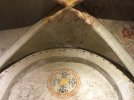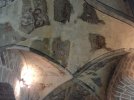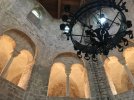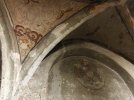The following thread is split off from this discussion about a 'planetary alignment' in early 2022.
Informed by Laura's biblical research and recent sessions with the Cs, it appears that as many as five centuries may have been 'added' to official chronology - specifically, between the end of the Roman Empire (whenever exactly that was) and the beginning of the Middle Ages.
With a view to researching and discussing this possibility, the following thread opens with the latest chapter from Pierre's new book, Mass Extinctions, Evolutionary Leaps, and the Virus-Information Connection, which is being published as it is written, here.
Here is part of chapter 19 which deals with 460 added years:
The years before the advent of the Plague of Justinian were marked by the worst tyranny imaginable. I extensively described the situation in a previous book[1]. A few words from Belisarus might suffice to sum up the nature of Justinian and his regime:
That Justinian was not a man, but a demon, as I have said, in human form, one might prove by considering the enormity of the evils he brought upon mankind.[2]
The Nikka riots ca. 532 AD might illustrate the deleterious socio-political context under Justinian’s reign. These were the most violent riots in the history of Constantinople, with half of city being destroyed and thirty thousand rioters killed[3].
Only four years later, a cometary event ca. 536 AD and its consequences, including the Plague of Justinian almost obliterated Europe.
Social and civilizational conditions after the Plague of Justinian
Extensive studies of the available evidence show that, during the 6th century A.D., any kind of human activity beyond basic survival vanished. Furthermore, between the 7th and the 9th centuries, human activity in the Roman Empire was virtually inexistent:
Houses: Building regressed from numerous elaborate stone houses to scattered wooden shacks.[4]
Metal: This flourishing industry during the Roman Empire ceased to exist. It was only during the 16th Century – a full 1,000 years later – that the level of industrial activity prior to the fall of Rome would be once more attained.[5]
Pottery: Widespread and elaborate products became very rare and progress stagnated so much that it’s impossible to distinguish 7th-century ceramics from those produced two centuries later.[6]
Ecclesiastical buildings: The very few churches built during this period were more than ten times smaller than the 4th-century St. Peter’s Basilica of Rome.[7] Only the cathedrals of the 11th century would attain similar sizes.
Farming and warfare: profound stagnation in both these fields for three centuries.[8]
Coinage: Sharp drop in the quality and quantity of coins in most regions of the Empire.[9]
Written documents: almost totally absent for three centuries.[10]
Soon after the last plague outbreak, after more than two centuries of survival and stagnation, civilization re-emerged around 800 AD with a renewed vitality. This period of blooming cultural activity is called the Carolingian Renaissance:
During this period, there was an increase of literature, writing, the arts, architecture, jurisprudence, liturgical reforms, and scriptural studies.[11]
The most salient effect of the Carolingian Renaissance was a moral regeneration, which is interesting because, at the time, lack of morality and ‘divine wrath’ (for example, in the form of comets and/or plagues) were closely associated[12]:
[The Carolingian Renaissance] had a spectacular effect on education and culture in Francia, a debatable effect on artistic endeavors, and an unmeasurable effect on what mattered most to the Carolingians, the moral regeneration of society.[13]
Most are familiar with the 79 AD eruption of Vesuvius, which buried Pompeii and Herculaneum overnight.

© John Martin 1822
The Destruction of Pompeii and Herculaneum
The most well-known eyewitness account of the eruption was not written by Pliny the Younger, as is generally believed, but much later in 1498, by Giovanni Giocondo[14], who claimed to have found Pliny’s original letters in Paris. Unfortunately, the original letters no longer exist.[15] what Giocondo found, and what he claimed to have found, are different in any way? Notice also that some other works by Giocondo are marked by controversy.[16] [17] [18]
In Antarctica, it’s the same story; no noticeable deposits. Notice that “the event” didn’t trigger a noticeable temperature drop either:

© Michael Sigl et al.
Ice-core records of sulfur from two ice cores in Greenland and Antarctica

© Smithsonian Institution
List of Vesuvius eruption between 536 AD and 79 AD
A number of authors, among them Heribert Illig and Gerhard Anwander[30], doubt the historicity of Charlemagne and argue that he was a mythical figure modeled after historical Constantine.

Constantine and Charlemagne on Cologne Cathédral
Informed by Laura's biblical research and recent sessions with the Cs, it appears that as many as five centuries may have been 'added' to official chronology - specifically, between the end of the Roman Empire (whenever exactly that was) and the beginning of the Middle Ages.
With a view to researching and discussing this possibility, the following thread opens with the latest chapter from Pierre's new book, Mass Extinctions, Evolutionary Leaps, and the Virus-Information Connection, which is being published as it is written, here.
Here is part of chapter 19 which deals with 460 added years:
Chapter 19: Society before and after both plagues
Social conditions before plague of Justinian
The years before the advent of the Plague of Justinian were marked by the worst tyranny imaginable. I extensively described the situation in a previous book[1]. A few words from Belisarus might suffice to sum up the nature of Justinian and his regime:
That Justinian was not a man, but a demon, as I have said, in human form, one might prove by considering the enormity of the evils he brought upon mankind.[2]
The Nikka riots ca. 532 AD might illustrate the deleterious socio-political context under Justinian’s reign. These were the most violent riots in the history of Constantinople, with half of city being destroyed and thirty thousand rioters killed[3].
Only four years later, a cometary event ca. 536 AD and its consequences, including the Plague of Justinian almost obliterated Europe.
Social and civilizational conditions after the Plague of Justinian
Extensive studies of the available evidence show that, during the 6th century A.D., any kind of human activity beyond basic survival vanished. Furthermore, between the 7th and the 9th centuries, human activity in the Roman Empire was virtually inexistent:
Houses: Building regressed from numerous elaborate stone houses to scattered wooden shacks.[4]
Metal: This flourishing industry during the Roman Empire ceased to exist. It was only during the 16th Century – a full 1,000 years later – that the level of industrial activity prior to the fall of Rome would be once more attained.[5]
Pottery: Widespread and elaborate products became very rare and progress stagnated so much that it’s impossible to distinguish 7th-century ceramics from those produced two centuries later.[6]
Ecclesiastical buildings: The very few churches built during this period were more than ten times smaller than the 4th-century St. Peter’s Basilica of Rome.[7] Only the cathedrals of the 11th century would attain similar sizes.
Farming and warfare: profound stagnation in both these fields for three centuries.[8]
Coinage: Sharp drop in the quality and quantity of coins in most regions of the Empire.[9]
Written documents: almost totally absent for three centuries.[10]
Soon after the last plague outbreak, after more than two centuries of survival and stagnation, civilization re-emerged around 800 AD with a renewed vitality. This period of blooming cultural activity is called the Carolingian Renaissance:
During this period, there was an increase of literature, writing, the arts, architecture, jurisprudence, liturgical reforms, and scriptural studies.[11]
The most salient effect of the Carolingian Renaissance was a moral regeneration, which is interesting because, at the time, lack of morality and ‘divine wrath’ (for example, in the form of comets and/or plagues) were closely associated[12]:
[The Carolingian Renaissance] had a spectacular effect on education and culture in Francia, a debatable effect on artistic endeavors, and an unmeasurable effect on what mattered most to the Carolingians, the moral regeneration of society.[13]
Most are familiar with the 79 AD eruption of Vesuvius, which buried Pompeii and Herculaneum overnight.
© John Martin 1822
The Destruction of Pompeii and Herculaneum
The most well-known eyewitness account of the eruption was not written by Pliny the Younger, as is generally believed, but much later in 1498, by Giovanni Giocondo[14], who claimed to have found Pliny’s original letters in Paris. Unfortunately, the original letters no longer exist.[15] what Giocondo found, and what he claimed to have found, are different in any way? Notice also that some other works by Giocondo are marked by controversy.[16] [17] [18]
Spewing ash, Vesuvius spewed a deadly cloud of ash and gases at 1.5 million tons per second, and to a height of 33 km.[19] Pulverized pumice and lava fragments piled up to 20 meters[20] deep,[21] leaving the city of Pompeii buried beneath four million tons of volcanic material and debris[22].
The eruption released 100,000 times the thermal energy of the atomic bomb of Hiroshima[23]. The estimated VEI[24] was 5 on a scale of 8, making it one of the largest known eruptions in the past 2,000 years.
The only problem is, in spite of this magnitude, it didn’t leave any signature whatsoever in Greenland ice cores:
The eruption released 100,000 times the thermal energy of the atomic bomb of Hiroshima[23]. The estimated VEI[24] was 5 on a scale of 8, making it one of the largest known eruptions in the past 2,000 years.
The only problem is, in spite of this magnitude, it didn’t leave any signature whatsoever in Greenland ice cores:
Major and trace element composition of the particles indicates that the tephra does not derive from Vesuvius but most likely originates from an unidentified eruption in the Aleutian arc. Using ash dispersal modelling, we find that only an eruption large enough to include stratospheric injection is likely to account for the sizeable (24–85 μm) ash particles observed in the Greenland ice at this time. Despite its likely explosivity, this event does not appear to have triggered significant climate perturbations, unlike some other large extra-tropical eruptions. In light of a recent re-evaluation of the Greenland ice-core chronologies, our findings further challenge the previous dating of this volcanic event to 79 CE.[25]
© Michael Sigl et al.
Ice-core records of sulfur from two ice cores in Greenland and Antarctica
© Smithsonian Institution
List of Vesuvius eruption between 536 AD and 79 AD
In contrast, the eruption of 540 AD is not only backed up by historical observations, but left very distinct marks in both Antarctica and Greenland and in temperature reconstructions. For some reason, it is the only eruption with no associated VEI.
Notice also, all the other alleged eruptions – in 172 AD, 203 AD, 222 AD, 379 AD, 472 AD and 512 AD – despite reaching, for several them, a VEI of 4 and 5 – didn’t leave any trace in Greenland and Antarctica ice cores and temperature reconstructions.
Could it be that just one eruption of Vesuvius (that of 540 AD, with its historical observations and confirmed ice cores) actually happened, while the other eruption (of 79 AD) didn’t happen?
That’s substantially what Mike Baillie proposes in his paper “Volcanoes, ice cores and tree rings; one story or two?”[26] In it he suggests that if no volcanic ash is to be found in ice cores corresponding to 79 AD (as shown by Plunkett et al.) then the real eruption – conventionally attributed to 79 AD – actually occurred in 540 AD.
If one eruption of Vesuvius became two, 461 years apart, could those 461 years have been added to the official timeline?
This time difference occurs elsewhere in historical chronology: the reign of Charlemagne[27] began in 768 AD, and the reign of Constantine began in 306 AD[28]. The difference between those two dates is 462 years.
The moral revival that marked the Carolingian Renaissance was centered on Christianity in general and on Constantine in particular:
Notice also, all the other alleged eruptions – in 172 AD, 203 AD, 222 AD, 379 AD, 472 AD and 512 AD – despite reaching, for several them, a VEI of 4 and 5 – didn’t leave any trace in Greenland and Antarctica ice cores and temperature reconstructions.
Could it be that just one eruption of Vesuvius (that of 540 AD, with its historical observations and confirmed ice cores) actually happened, while the other eruption (of 79 AD) didn’t happen?
That’s substantially what Mike Baillie proposes in his paper “Volcanoes, ice cores and tree rings; one story or two?”[26] In it he suggests that if no volcanic ash is to be found in ice cores corresponding to 79 AD (as shown by Plunkett et al.) then the real eruption – conventionally attributed to 79 AD – actually occurred in 540 AD.
If one eruption of Vesuvius became two, 461 years apart, could those 461 years have been added to the official timeline?
This time difference occurs elsewhere in historical chronology: the reign of Charlemagne[27] began in 768 AD, and the reign of Constantine began in 306 AD[28]. The difference between those two dates is 462 years.
The moral revival that marked the Carolingian Renaissance was centered on Christianity in general and on Constantine in particular:
This revival used Constantine's Christian empire as its model, which flourished between 306 and 337. Constantine was the first Roman emperor to convert to Christianity and left behind an impressive legacy of military strength and artistic patronage.
Charlemagne saw himself as the new Constantine and instigated this revival by writing his Admonitio generalis (789) and Epistola de litteris colendis (c.794-797). In the Admonitio generalis, Charlemagne legislates church reform, which he believes will make his subjects more moral and in the Epistola de litteris colendis, a letter to Abbot Baugulf of Fulda, he outlines his intentions for cultural reform. Most importantly, he invited the greatest scholars from all over Europe to come to court and give advice for his renewal of politics, church, art and literature.[29]
A number of authors, among them Heribert Illig and Gerhard Anwander[30], doubt the historicity of Charlemagne and argue that he was a mythical figure modeled after historical Constantine.
Constantine and Charlemagne on Cologne Cathédral
This makes sense since more or less 300 years were blank. But as demonstrated by Ward Perkins[31], blank doesn’t mean added.
Might it in fact be other way around: was a mythical Constantine modeled after the historical figure of Charlemagne? Another piece of evidence supporting this hypothesis is the forgery of the Constantine donation:
Might it in fact be other way around: was a mythical Constantine modeled after the historical figure of Charlemagne? Another piece of evidence supporting this hypothesis is the forgery of the Constantine donation:
Valla showed that the document could not possibly have been written in the historical era of Constantine (4th Century) because its vernacular style dated conclusively to a later era (8th Century). One of Valla's reasons was that the document contained the word satrap which he believed Romans such as Constantine I would not have used.[32]
In other words, Constantine’s legacy was to grant supreme temporal and spiritual power to the Church, and its main proof was a forgery (probably conducted at the behest of Pepin Le Bref[33], the father of Charlemagne).
One reason why 460 years may have been added is because this gave plenty of ‘time’ to establish a whole genealogy of Popes and Saints, dozens of which, incidentally, have been proven to be mythical.[34] [35]
A final question: why, during the time of Saint Paul, did Christianity not really catch on? In the 26 years (29 AD – 55 AD) he spent preaching, Paul gathered at most one thousand followers.[36] And yet, just a few centuries later, Christianity has taken Western Europe by storm, becoming the new state religion of the Germanic Holy Empire.
After all, the central values at the core of Christianity – mercy, forgiveness and love – were so foreign to most at the time[37].
Might it be that the collective trauma of cometary bombardment and/or a newly introduced virus triggered this evolutionary leap?
If 460 years were added the official time, then Paul was right he said to the Corinthians – which is dated from 43-46 AD[38]:
One reason why 460 years may have been added is because this gave plenty of ‘time’ to establish a whole genealogy of Popes and Saints, dozens of which, incidentally, have been proven to be mythical.[34] [35]
A final question: why, during the time of Saint Paul, did Christianity not really catch on? In the 26 years (29 AD – 55 AD) he spent preaching, Paul gathered at most one thousand followers.[36] And yet, just a few centuries later, Christianity has taken Western Europe by storm, becoming the new state religion of the Germanic Holy Empire.
After all, the central values at the core of Christianity – mercy, forgiveness and love – were so foreign to most at the time[37].
Might it be that the collective trauma of cometary bombardment and/or a newly introduced virus triggered this evolutionary leap?
If 460 years were added the official time, then Paul was right he said to the Corinthians – which is dated from 43-46 AD[38]:
I mean, brothers and sisters, the appointed time has grown short; from now on, let even those who have wives be as though they had none, and those who mourn as though they were not mourning, and those who rejoice as though they were not rejoicing, and those who buy as though they had no possessions, and those who deal with the world as though they had no dealings with it. For the present form of this world is passing away[39]
[1] Lescaudron, 2014. Chapter 34: Historic evidence of a cosmic-human connection
[2] Procopius (1927) “The Secret History”, New York: Covici Friede. chapter XVIII, translated by Richard Atwater,
[3] Procopius. (1914) “History of the Wars” Volume I: Books 1-2. Harvard University Press.
[4] Ward-Perkins, Bryan (2005) “The fall of Rome”. Oxford University Press p.95 & p.111
[5] Ibid, pp. 96
[6] Niemitz, Hans-Ulrich (2000), Did the early middle age really exist, p.5
[7] Ward-Perkins, op. cit., pp. 148-149
[8] White Jr., Lynn (1968). “Die mittelalterliche Technik und der Wandel der Gesellschaft”. München
[9] Ward-Perkins, op. cit., pp. 110-117
[10] Hardouin, Jean, (2017) “The Prolegomena”, independently published. Translated by Edwin Johnson. p. 64
[11] Wikipedia contributors. (2021) ‘’Carolingian Renaissance’’ Wikipedia
[12] Lescaudron, 2014 chapter 32-35
[13] Contreni, John G. (1984) "The Carolingian Renaissance". Cambridge University Press
[14] Wikipedia contributors. (2021) “Giovanni Giocondo” Wikipedia
[15] Tom Higgins (2011) “Pliny Correspondence With Trajan John Bartrom” Scribd
[16] Kaiser, R. (2017) “Caesar's Rhine Bridge and Its Feasibility in Giovanni Giocondo's Expositio pontis (1513)”. In Knowledge, Text and Practice in Ancient Technical Writing (pp. 68-92) Cambridge University Press
[17] Stenhouse, William (2003) “Georg Fabricius and Inscriptions as a Source of Law.” Renaissance Studies 17, no. 1 96–107
[18] De Raedt N. (2016) “Architecture” In Encyclopedia of Renaissance Philosophy. Springer
[19] Time editors (1956) “Man of Pompeii" Time
[20] 70 ft
[21] Sigurðsson, Haraldur et al. (1982) "The Eruption of Vesuvius in A. D. 79: Reconstruction from Historical and Volcanological Evidence" American Journal of Archaeology 86 (1)
[22] Noreen G. (2021) “A World Buried in the Eruption” Eruption Vesuvius
[23] Ibid
[24] Volcanic Explosivity Index
[25] Plunkett, G. et al. (2021) “No evidence for tephra in Greenland from the historic eruption of Vesuvius in 79 CE: Implications for geochronology and paleoclimatology” Climate of the Past
[26] Baillie, M. (2010) “Volcanoes, ice-cores and tree-rings: One story or two?” Antiquity, 84(323), 202-215
[27] Wikipedia contributors (2021) “Charlemagne” Wikipedia
[28] Mark, J. J. (2019) “Donation of Constantine” World History Encyclopedia
[29] Nancy Ross (2021) “Carolingian art, an introduction” Khan Academy
[30] Heribert Illig, Gerhard Anwander (2002) “Bayern in der Phantomzeit. Archäologie widerlegt Urkunden des frühen Mittelalters”
[31] See: “Social and civilizational conditions after the plagues”
[32] Jeremy Norman (2021) “Lorenzo Valla Proves that the Donation of Constantine is a Forgery” History Of Information
[33] Ross, 2021
[34] Wikipedia contributors (2021) “List of Christian martyrs” Wikipedia
[35] Bauer, S. (2021). “Who Wrote the Lives of the Popes? Permutations of a Renaissance Myth’’ The Catholic Historical Review 107(1), 28-49
[36] Laura Knight-Jadczyk (2021) “From Paul to Mark: PaleoChristianity” Red Pill Press
[37] Mert Toker, “What historic/ancient civilization or society had the lowest preference for mercy?” Quora
[38] Laura Knight-Jadczyk, 2021
[39] 1 Cor 7: 29-31 (NRSVCE)
[2] Procopius (1927) “The Secret History”, New York: Covici Friede. chapter XVIII, translated by Richard Atwater,
[3] Procopius. (1914) “History of the Wars” Volume I: Books 1-2. Harvard University Press.
[4] Ward-Perkins, Bryan (2005) “The fall of Rome”. Oxford University Press p.95 & p.111
[5] Ibid, pp. 96
[6] Niemitz, Hans-Ulrich (2000), Did the early middle age really exist, p.5
[7] Ward-Perkins, op. cit., pp. 148-149
[8] White Jr., Lynn (1968). “Die mittelalterliche Technik und der Wandel der Gesellschaft”. München
[9] Ward-Perkins, op. cit., pp. 110-117
[10] Hardouin, Jean, (2017) “The Prolegomena”, independently published. Translated by Edwin Johnson. p. 64
[11] Wikipedia contributors. (2021) ‘’Carolingian Renaissance’’ Wikipedia
[12] Lescaudron, 2014 chapter 32-35
[13] Contreni, John G. (1984) "The Carolingian Renaissance". Cambridge University Press
[14] Wikipedia contributors. (2021) “Giovanni Giocondo” Wikipedia
[15] Tom Higgins (2011) “Pliny Correspondence With Trajan John Bartrom” Scribd
[16] Kaiser, R. (2017) “Caesar's Rhine Bridge and Its Feasibility in Giovanni Giocondo's Expositio pontis (1513)”. In Knowledge, Text and Practice in Ancient Technical Writing (pp. 68-92) Cambridge University Press
[17] Stenhouse, William (2003) “Georg Fabricius and Inscriptions as a Source of Law.” Renaissance Studies 17, no. 1 96–107
[18] De Raedt N. (2016) “Architecture” In Encyclopedia of Renaissance Philosophy. Springer
[19] Time editors (1956) “Man of Pompeii" Time
[20] 70 ft
[21] Sigurðsson, Haraldur et al. (1982) "The Eruption of Vesuvius in A. D. 79: Reconstruction from Historical and Volcanological Evidence" American Journal of Archaeology 86 (1)
[22] Noreen G. (2021) “A World Buried in the Eruption” Eruption Vesuvius
[23] Ibid
[24] Volcanic Explosivity Index
[25] Plunkett, G. et al. (2021) “No evidence for tephra in Greenland from the historic eruption of Vesuvius in 79 CE: Implications for geochronology and paleoclimatology” Climate of the Past
[26] Baillie, M. (2010) “Volcanoes, ice-cores and tree-rings: One story or two?” Antiquity, 84(323), 202-215
[27] Wikipedia contributors (2021) “Charlemagne” Wikipedia
[28] Mark, J. J. (2019) “Donation of Constantine” World History Encyclopedia
[29] Nancy Ross (2021) “Carolingian art, an introduction” Khan Academy
[30] Heribert Illig, Gerhard Anwander (2002) “Bayern in der Phantomzeit. Archäologie widerlegt Urkunden des frühen Mittelalters”
[31] See: “Social and civilizational conditions after the plagues”
[32] Jeremy Norman (2021) “Lorenzo Valla Proves that the Donation of Constantine is a Forgery” History Of Information
[33] Ross, 2021
[34] Wikipedia contributors (2021) “List of Christian martyrs” Wikipedia
[35] Bauer, S. (2021). “Who Wrote the Lives of the Popes? Permutations of a Renaissance Myth’’ The Catholic Historical Review 107(1), 28-49
[36] Laura Knight-Jadczyk (2021) “From Paul to Mark: PaleoChristianity” Red Pill Press
[37] Mert Toker, “What historic/ancient civilization or society had the lowest preference for mercy?” Quora
[38] Laura Knight-Jadczyk, 2021
[39] 1 Cor 7: 29-31 (NRSVCE)
Attachments
Last edited by a moderator:











